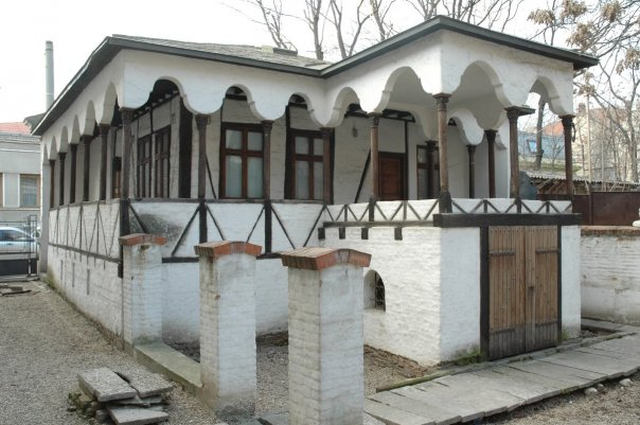Burgher’s house in Bucharest
Voina House is believed to be the oldest surviving private residence in Bucharest.

Christine Leșcu, 18.10.2020, 14:00
Although Bucharest is a relatively
old city, being first mentioned in historical documents in 1459, its oldest surviving
buildings date from the second half of the 19th century. You do,
find, the odd exception, though, such as a house located on one of the city’s
oldest streets called Șerban Vodă Road and which experts believe dates from
around 1790. Voina House, as it is known, after the name of its last owner, is quite
special because it is the only burgher’s house from the 18th century
to survive in Bucharest and because its architecture is a mixture of Romanian
traditional elements and Balkan influences. Not to mention that it is located
on a street of great historical importance, Șerban Vodă Road or The Beylik’s Bridge
as it was once known. Iozefina Postăvaru, an art historian at the National
Heritage Institute, will be making a foray into the history of this street:
Ruler Radu Șerban, who reigned
between 1602 and 1611, issued a decree referring to a small road which ran from
the Old Court, or the Princely Court in the historical centre of present-day Bucharest,
to the south, all the way to Giurgiu and then further, to Constantinople. The
ruler ordered that this road be paved with wood. Because of this measure, the
street would be named after him: Șerban Vodă Road. Later, however, during the
Phanariot rule, the street was known as Beylik’s Bridge, because it was
transited by the diplomatic envoys from Constantinople or Istanbul to Bucharest
and further to Europe. Whenever a new Phanariot ruler would be appointed, or dismissed,
as the case may be, his procession would pass through this street. The processions
accompanying the arrival of a new ruler were prepared in detail and involved a lot
of pomp and ceremony. We can just imagine the locals attending enthusiastically
and following the new ruler’s procession all the way to the princely court, all
the more so as it was customary on such occasions to toss coins into the crowds.
The name Beylik’s Bridge came from
the word bey, which is the title given by the Ottoman Empire, which had
control of Wallachia, to high-ranking officials it appointed as provincial governors,
a title also held by the rulers in Bucharest. The latter would enter the country
by the road built by Radu Șerban. In time, new neighbourhoods mushroomed on
either side of this road, such as the Slobozia Domnească Mahalla, the St. Spyridon Mahalla,
and the Flamânda Mahalla. It is in this somewhat hilly part of the city, which
in the old times used to be covered by woods and vineyards, that a new social category
would be born. Art historian Iozefina Postăvaru explains:
It was an economically and socially mixed area. It was
an important street, and boyar residences stood side by side with the homes of the
petty nobility and those of craftsmen and merchants. The area would, however
gradually come to be dominated by a new social category, namely that of townspeople,
burghers, or the early bourgeoisie of Bucharest, which was largely comprised of
builders. Some of them were brought over by the rulers to work on various new church
structures. A genuine school was formed around these builders, for construction
and other professions. Merchants also formed part of this new social category,
as well as people who didn’t have a specific profession but who were definitely
not farmers.
Casa Voina was the home of one such burgher. City records
show that it saw a number of alterations in time for which its owners asked
permission from the city authorities. For example, around 1890, the building underwent
a change in its external appearance to be more in tune with the style fashionable
at the time. This is why, if viewed from the street, the house is no different
than other buildings in the area whose facades are decorated in 19th
century style, with sombre Neo-classical elements. It’s when we step inside the
garden that we notice it dates from a different era. Art historian Iozefina Postăvaru explains:
Once we enter the courtyard it’s like stepping a further
hundred years back in time, for the side of the house facing away from the
street has been unchanged from 1790. I’m referring to two facades surrounded by
a porch with wooden columns and carved capitals supporting trefoil arches. It’s
similar to Manuc’s Inn from the historical centre of Bucharest, except for this
row of columns. This type of building is typical of Balkan vernacular or
traditional architecture and is also reminiscent of the brâncovenesc style seen in Wallachia,
with the trefoil arches supported by pillars being characteristic to this style
that developed during the reign of Constantin Brâncoveanu.
The house was nationalised in 1950 and then rented out to various small craftsmen’s
workshops, including a tapestry workshop at some point. But the building was
not looked after and in the 1970s it was completely abandoned.
In the early 1990s, the burgher’s house on Șerban Vodă Road, which had in the meantime been
declared a historical building, came under the administration of what is today
the National Heritage Institute. Restored in 1998, it still needs further
maintenance works. As for its future use, there are plans to establish here a
cultural heritage information and promotion centre.





























